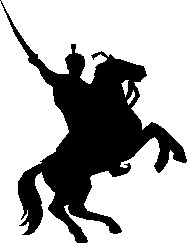
MaharanaPratapa
Extant in Kaliyuga's years from 3640 to 3698 (i.e. from 1539 to 1597 A.D.)
Maharana Pratap, who struggled against slavery all through his life and kept
aloft always the saffron coloured flag of Hindutva, through his character
and conduct provided an example representing the Indian consciousness of retaliation
and antagonism. At a time when many other Rajput kings, forgetting their righteous
pride in their own Dharma, were seeking an alliance with the Mughal invader
ruler and some were even offering their daughters to establish a relationship
with him and the Hindus were being befooled by Deen-e-llahi ( the new fangled
common Godly religion ) Maharana Pratap was the only brave person who was
working for foiling the clever trick of Akbar and was hitting at his vain-glorious
conceit. Crest jewel of the crown of Mewar, Pratap was born in the dignified
family of Bappa Raval. He was the grandson of Rana Sanga ( Sangram Singh )
who is famous for receiving as many as eighty wounds on his body, in a battle,
and yet continued fighting. In the sacred battle-field of Haldighati of Rajputana
the extra-ordinary bravery that was shown by Maharana Pratap and his immortal
self-sacrificing Bhil and Rajput soldiers in their fight with the Mughal,
the glorious tale of the same has become the golden page of the History of
the Hindu Race. Making a resolve to free Chittaud Gadh at his heart Maharana
Pratap accepted staying in jungle and had to undergo limitless hardships (
and suffering ) for the sake of the freedom of his country. Having received
unimaginable financial help from the great patriot Bhamashah, Maharana Pratap
reorganised his army, and within his own life time regained as many as 77
out of 80 of his forts lost to the enemy.
Rajputs
räjpoots [Sanskrit,=son of a king], dominant people of Rajputana, an
historic region now almost coextensive with the state of Rajasthan, NW India.
The Rajputs are mainly Hindus (although there are some Muslim Rajputs) of
the warrior caste; traditionally they have put great value on etiquette and
the military virtues and take great pride in their ancestry. Of these exogamous
clans, the major ones were Rathor, Kachchwaha, Chauhan, and Sisodiya. Their
power in Rajputana grew in the 7th cent., but by 1616 all the major clans
had submitted to the Mughals. With the decline of Mughal power in the early
18th cent., the Rajputs expanded through most of the plains of central India,
but by the early 19th cent. they had been driven back by the Marathas, Sikhs,
and British. Under the British, many of the Rajput princes maintained independent
states within Rajputana, but they were gradually deprived of power after India
attained independence in 1947.
![]()